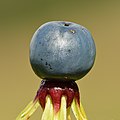| Paris quadrifolia | |
|---|---|
 | |
| Paris quadrifolia in Ciemnik, Poland | |
| Scientific classification | |
| Kingdom: | Plantae |
| Clade: | Tracheophytes |
| Clade: | Angiosperms |
| Clade: | Monocots |
| Order: | Liliales |
| Family: | Melanthiaceae |
| Genus: | Paris |
| Species: | P. quadrifolia |
| Binomial name | |
| Paris quadrifolia | |
| Synonyms [2] | |
| |


Paris quadrifolia, the herb Paris [4] or true lover's knot, is a species of flowering plant in the family Melanthiaceae. It occurs in temperate and cool areas throughout Eurasia, from Spain to Yakutia, and from Iceland to Mongolia. [2] It prefers calcareous soils and lives in damp and shady places, especially old established woods and stream banks.
Contents
P. quadrifolia is in decline in Europe due to loss of habitat. [5] In Iceland, for example, it is on the red list. [6]





